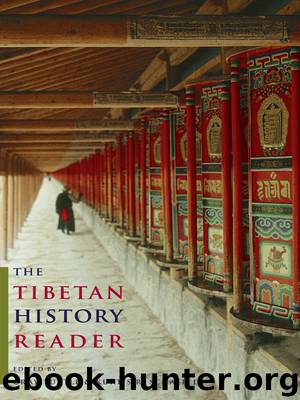The Tibetan History Reader by Gray Tuttle

Author:Gray Tuttle
Language: eng
Format: epub
Tags: HIS008000, History/Asia/China, REL007050, Religion/Buddhism/Tibetan
Publisher: Columbia University Press
Published: 2013-03-11T16:00:00+00:00
Chapter 22
EXPERIENCE, EMPIRICISM, AND THE FORTUNES OF AUTHORITY
TIBETAN MEDICINE AND BUDDHISM ON THE EVE OF MODERNITY
Janet Gyatso
Where can one draw the line between the authority of tradition to focus our observations of the physical world and observation’s potential to challenge accepted beliefs? If Buddhist tantric theory states that there are channels of energy running up and down the center of the human torso and these are not found upon inspection, how can one adjudicate between the Buddha’s word and empirical observation? In Tibet these questions were never more poignant than in the medical arts, for the visceral reality of the human body consistently confronted the claims of the medical tradition. Janet Gyatso places the fulcrum point at which empirical knowledge began to offer an abiding challenge to traditional knowledge of the body in the late seventeenth century, when the Fifth Dalai Lama’s rule ushered in a renaissance age for art, science, and government. In Lhasa the court physicians at the Potala advanced pharmacology by rigorously collecting, comparing, and cataloging plants. They imported new treatments from Nepal and India. And they began, according to Gyatso, to perform autopsies upon human cadavers for the first time in Tibetan history. In detailing select vignettes from the lives of several key physicians at the Lhasa court and isolating the central challenge that empiricism as a discipline brings to traditional authority, Gyatso signals the emergence of a promising subfield in Tibetan historical studies—the history of science.
Sometime around 1670, Darmo Menrampa, one of an inner group of physicians close to the Fifth Dalai Lama, set up a laboratory in a park in Lhasa. He and his students proceeded to dissect four human corpses—two male, two female, two old, two young—in order to count their bones. He wrote briefly of the event in an anatomical treatise, after surveying received tradition on how to count the bones in the body, which were classically said to add up to 360. This number, Darmo notes, is explained in the texts as entailing that one count the sections of the skull as four. But, he says, “My students and I based ourselves instead on there being nine sections of the skull, and thus [we count] 365.”1
We have to admire Darmo’s deftness. The number of bones that the physician and his acolytes “determined with precision, and through naked illustration” confirms the canonical number of 360. He also hints at the possibility of variation, if, for example, one were to recognize a different number of sections in the skull. But then Darmo goes on to call into question the notion of a definitive count altogether, suggesting a horizon of undecidability. Such undecidability would ensue if, instead of counting—as he and his students did—only the bones near in size to “the span between fingertip and elbow and the width of a finger,” one were also to reckon “the numerous small bones that are merely the size of a roasted bean.”
The idea that properties of the physical world cannot be represented definitively by canonical doctrine might remind us of issues germane to the birth of Western empiricism.
Download
This site does not store any files on its server. We only index and link to content provided by other sites. Please contact the content providers to delete copyright contents if any and email us, we'll remove relevant links or contents immediately.
| Africa | Americas |
| Arctic & Antarctica | Asia |
| Australia & Oceania | Europe |
| Middle East | Russia |
| United States | World |
| Ancient Civilizations | Military |
| Historical Study & Educational Resources |
Confession of a Buddhist Atheist by Stephen Batchelor(595)
Moments of Mindfulness by Thich Nhat Hanh(579)
Mindfulness by Sarah Shaw(537)
The All-Pervading Melodious Drumbeat by Ra Yeshe Senge(514)
Why I Am Not a Buddhist by Evan Thompson(471)
Being Human in a Buddhist World by Janet Gyatso(469)
The All-Pervading Melodious Drumbeat by Senge Ra Yeshe(457)
Buddhism by Paul Williams(450)
Tantric Ethics by Je Tsongkhapa(391)
A Buddhist Bible by Goddard Dwight(389)
Shingon Refractions by Mark Unno(384)
Radical Dharma by Rev. angel Kyodo williams & Rod Owens & Jasmine Syedullah(381)
The Heart of Unconditional Love by Tulku Thondup(378)
Manual of Zen Buddhism by Daisetz Teitaro Suzuki(357)
The Birth of Insight: Meditation, Modern Buddhism, and the Burmese Monk Ledi Sayadaw by Erik Braun(348)
The Idries Shah Anthology by Idries Shah(345)
Cultivating Spirituality: A Modern Shin Buddhist Anthology by Mark L. Blum;Robert F. Rhodes(345)
The Heart of Understanding: Commentaries on the Prajnaparamita Heart Sutra by Thich Nhat Hanh(338)
Understanding the Case Against Shukden: The History of a Contested Tibetan Practice by Gavin Kilty(336)
